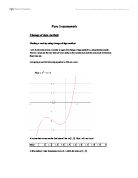Pure 2 Coursework:
Testing Root Methods
A. Hayton
Pure Mathematics 2 Coursework:
Testing root methods
Aim:
My aim is to find the advantages and disadvantages of three different root-finding methods: The Change of sign method, The Newton-Raphson method and Fixed Point Iteration.
Method 1: Decimal Search (Change of Sign Method)
The decimal search method is used to find the first root of y=x5-x+0.2 - the table of our working is shown below. As you can see, when we find the sign changes we can then move on and find the next decimal place.
Error Bounds of this root
As we can see from the table, the error bounds of this root are -1.044762 and -1.044761 (the root lies in between these two points because y is negative for one and positive for the other). The root is found in 49 iterations.
Failure of the Change of Sign Method
The root closest to x=1 cannot be found because the decimal search method will stop when it reaches around x=0.3 (finding the first root in between 0 and 1) this is a drawback when there are two or more roots in between two integer values.
Method 2: Newton-Raphson Method
Using Autograph again, the roots for y=x5 -3x2 + 1 were found using the Newton-Raphson Method:
This illustration demonstrates how we acquire the first root of the equation. The tangent is found at a point and then the point where this tangent crosses x=0 is found. The process is then repeated from this point. The equation for Newton-Raphson iterations is:
Testing Root Methods
A. Hayton
Pure Mathematics 2 Coursework:
Testing root methods
Aim:
My aim is to find the advantages and disadvantages of three different root-finding methods: The Change of sign method, The Newton-Raphson method and Fixed Point Iteration.
Method 1: Decimal Search (Change of Sign Method)
The decimal search method is used to find the first root of y=x5-x+0.2 - the table of our working is shown below. As you can see, when we find the sign changes we can then move on and find the next decimal place.
Error Bounds of this root
As we can see from the table, the error bounds of this root are -1.044762 and -1.044761 (the root lies in between these two points because y is negative for one and positive for the other). The root is found in 49 iterations.
Failure of the Change of Sign Method
The root closest to x=1 cannot be found because the decimal search method will stop when it reaches around x=0.3 (finding the first root in between 0 and 1) this is a drawback when there are two or more roots in between two integer values.
Method 2: Newton-Raphson Method
Using Autograph again, the roots for y=x5 -3x2 + 1 were found using the Newton-Raphson Method:
This illustration demonstrates how we acquire the first root of the equation. The tangent is found at a point and then the point where this tangent crosses x=0 is found. The process is then repeated from this point. The equation for Newton-Raphson iterations is:







